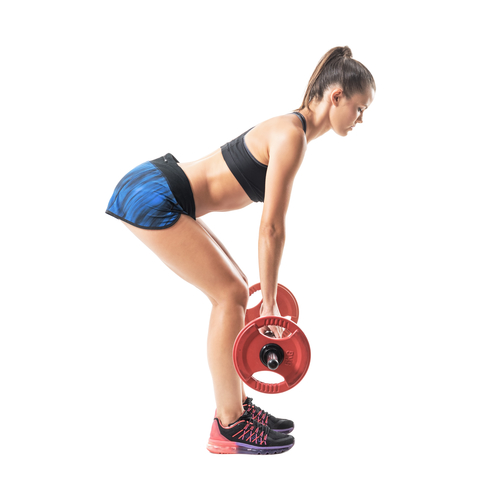A Romanian deadlift (RDL) is a variation of a conventional deadlift in which the weight is not set back down on the ground, thereby placing constant tension on the muscles involved in the movement. This deadlift variation is considered an accessory exercise, and used as an excellent tool for hamstring hypertrophy versus the goal of max strength when performing conventional deadlifts.
The RDL can be used as a tool with most fitness clients, once they have mastered a hip hinge movement. The greatest risk with any deadlift variation is the inability to stabilize the spine. An unstable and loaded spine is a recipe for injury.
Muscle Emphasis
The primary muscles stressed in this movement are the hamstrings, gluteals, the upper trapezius, and the erector spinae in particular. The secondary muscles stressed are your abdominal muscles, shoulders, gastrocnemius, and forearms.
Romanian Deadlift Execution
Starting Position
Just like conventional and stiff-legged deadlifts, start with a weighted bar placed just over your forefoot, stance is shoulder-widthapart. Reach down for the bar with a flat back by hinging at the hips, and bending the knees so that the things are parallel to the floor. Grip the bar in an interlocking grip, one palm up, one palm down. Lift the bar up off the floor by driving through the hips until the bar is against your upper thighs, arms extended, shoulders squeezed back.
Alternatively, start with the bar on a rack. This standing position is the start position for an RDL.
Movement
- Keep your back straight and the bar as close as possible to your legs as you lower the bar.
- Stop when the bar comes just below the knees. You do not return the weight to the ground. This is the main distinction between a conventional deadlift and a Romanian deadlift.
Training Tips
- Reverse the interlocking grip on every set performed
- Use less weight than your conventional deadlift and even stiff-legged deadlift. Aim for three to five sets of six to 10 reps or 12-15 reps with a more modest weight for two or three sets.
Variations
The single-leg RDL is a popular movement for balance and glute activation. Having a client hinge forward with one foot on the ground and one leg straight in the air behind them may help create the muscle memory necessary for a bilateral hip hinge motion, i.e., two-legged deadlifts!
[sc name=”resistance” ]
NFPT Publisher Michele G Rogers, MA, NFPT-CPT and EBFA Barefoot Training Specialist manages and coordinates educational blogs and social media content for NFPT, as well as NFPT exam development. She’s been a personal trainer and health coach for over 20 years fueled by a lifetime passion for all things health and fitness. Her mission is to raise kinesthetic awareness and nurture a mind-body connection, helping people achieve a higher state of health and wellness. After battling and conquering chronic back pain and becoming a parent, Michele aims her training approach to emphasize fluidity of movement, corrective exercise, and pain resolution. She holds a master’s degree in Applied Health Psychology from Northern Arizona University. Follow Michele on Instagram.

